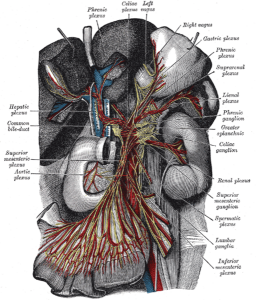What is the solar plexus?
by Ryan Gregory, July 29th, 2012We’re often instructed to “aim for the solar plexus” with our strikes. Obviously it’s an important target — but where, or what, is it?
If you ask a New-Ager, the solar plexus is the site of a “chakra”, specifically the one dealing with power and will and self-esteem and whatever. It’s associated with the colour yellow and there’s also a point on the foot that you can press to relieve headaches, apparently.

Needless to say, I am not particularly interested in this take on the solar plexus.
In scientific terms, the “solar plexus” is better known as the “celiac plexus”. The term “plexus” refers to a network — in this case, a network of nerves. “Celiac” refers to the abdomen. So, the celiac plexus is a network of nerves located in the abdomen. It is one of several nerve networks in the body.
Medline Entry: celiac plexus
A nerve plexus that is situated in the abdomen behind the stomach and in front of the aorta and the crura of the diaphragm, surrounds the celiac artery and the root of the superior mesenteric artery, contains several ganglia of which the most important are the celiac ganglia, and distributes nerve fibers to all the abdominal viscera — called also solar plexus

The colloquial name “solar plexus” comes from the radiating pattern of nerves, like the rays of the Sun.

The target in question is located along the midline of the body a few inches above the navel and just below the bottom of the ribs.

When you strike this area, you are not actually hitting the celiac plexus directly; it is located behind the stomach, after all. Indeed, it would probably be more accurate to just say that you’re punching the opponent “in the stomach” — except that most people don’t know where the stomach is, and take “stomach” to mean the belly (which would actually be the intestines). In any case, a strike to the solar plexus region commonly causes a spasm of the diaphragm that leads to the sensation of “having the wind knocked out”. Of course, the same result can occur from falling hard onto one’s back. In some cases, the celiac plexus itself can be affected by a strike, which may lead to effects on the organs to which it is connected.
Results may vary if you try to punch the “solar plexus” point on the bottom of the feet.

 Brazilian Jiu-Jitsu
Brazilian Jiu-Jitsu
 Kodokan Judo
Kodokan Judo


